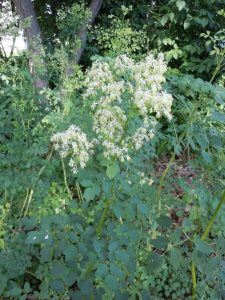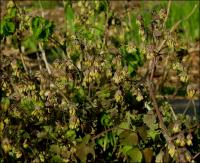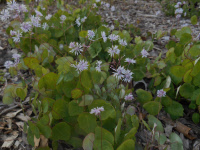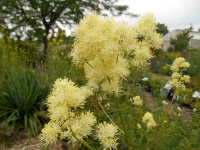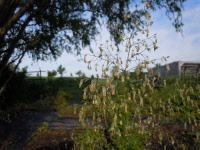Shop
Showing 729–736 of 788 results
-
Thalictrum dasycarpum Purple meadowrue Z 4-7
Panicles of delicate dangling ivory flowers May to July, purple stems
Panicles of delicate dangling ivory flowers May to July, purple stems.
Size: 4-5’ x 2’
Care: sun to part shade in moist well-drained to moist soil
Native: All North America except Atlantic & Pacific coasts and northern Canada, Wisconsin nativeThalictrum is from Greek meaning “to flourish” or “look green.” Collected for gardens by 1842. Used by Native Americans to enliven horses by giving them seeds or rubbing a poltice on their muzzles. (Pawnee & Lakota). Meskwaki, Ponca & Potawatomi used as an aphrodisiac. Potawatomi smoked a mixture of this and tobacco before meeting their woman. HoChunk used it to perfume smoke. For Potawatomi smoking dried seeds brought luck in hunting. Oneidas consider this a medication for kidney ailments. Ponca boys made flutes from the hollow stems. Winnebago perfumed smoke with this. Lakotaa Sioux fed this to horses to stimulate energy and masticated then rubbed it on their skin to repel insects.
-
Thalictrum delavayi syn. Thalictrum dipterocarpum Yunnan meadow rue Z 4-7
Purple to lavender flowers of sepals and stamens from July to August. Delicate-looking leaflets smaller than on most other Meadowrues. One of internationally known garden designer Piet Oudolf’s 100 “MUST HAVE” plants, Gardens Illustrated 94 (2013)
ARCHIVED
Note: This is a plant not currently for sale. This is an archive page preserved for informational use.
Purple to lavender flowers of sepals and stamens from July to August. Delicate-looking leaflets smaller than on most other Meadowrues. One of internationally known garden designer Piet Oudolf’s 100 “MUST HAVE” plants, Gardens Illustrated 94 (2013)
Size: 30” x 20”
Care: sun - part shade in moist humusy soil
Native: Tibet and China
Wildlife Value: Attracts Black swallowtail butterfly
Awards: England’s Royal Horticultural Society Award of Garden Merit.Thalictrum is from Greek meaning “to flourish” or “look green.” This species discovered by and named for Pére Jean Delavay (1838-1895), French missionary to China. Delavay found about 1500 new species in his three (3) trips to China. He sent his discoveries to the Jardin des Plantes in Paris. In 1880 he contracted bubonic plague while in China, which disabled him the remainder of his life.
-
Thalictrum dioicum Early meadowrue Z 5-9
Chartreuse blooms in spring
ARCHIVED
Note: This is a plant not currently for sale. This is an archive page preserved for informational use.
Hanging chartreuse blooms dangle from the stems in spring
Size: 20" x 24"
Care: shade to part shade in moist or moist well-drained soil.
Native: Quebec west to No. Dakota, south to Georgia, Wisconsin native
Wildlife Value: Attracts Black swallowtail butterfly. Deer resistant.Thalictrum is from Greek meaning “to flourish” or “look green.” Cherokee made an infusion of the root to cure nausea and diarrhea. Iroquois used it to remedy sore eyes and heart palpitations. The plant also would “make you crazy.” One of 1st No. American plants sent to Europe – grew in Tradescant the Elder’s South Lambeth nursery in 1634. Collected again by Rev. John Banister who moved to colonial Virginia in 1678. A gunman mistakenly shot and killed him while he collected plants. Scotsman Thomas Drummond collected this on the eastern base of the Rocky Mountains. Grown at America’s 1st botanic garden, Elgin Botanic Garden 1811.
-
Thalictrum flavum syn. T. glaucum Yellow meadrowrue Z 4-8
Fluffy, pale yellow flower clusters in mid-summer atop lacy, blue-gray foliage
Fluffy, pale yellow flower clusters in mid-summer atop lacy, blue-gray foliage
Size: 4' x 2'
Care: Sun to part shade in moist or moist well-drained soil
Native: Spain to NE Africa
Wildlife Value: Attracts Black swallowtail butterfly
Awards: England’s Royal Horticulture Society Award of Garden Merit.The species was identified by Dioscordies in De Materica Medica for medicinal use around 70 A.D. Species grown at America’s 1st botanic garden, Elgin Botanic Garden 1811. This subspecies was probably in gardens before 1900.
-
Thalictrum ichangense Dwarf meadowrue, Chinese meadowrue, in China called “dun ye tang song cao” Z 5-7
Airy sprays of palest of pink flowers in early summer & sporadically reblooming. Pretty foliage - flushed with purple and marbled grey, think Begonia leaves.
Airy sprays of palest of pink flowers in early summer & sporadically reblooming. Pretty foliage – flushed with purple and marbled grey, think Begonia leaves.
Size: 6” x 6”
Care: shade to part shade in moist well-drained soil
Native: forests and damp rocky ledges in Western ChinaDescribed in literature 1888. Collected for the West by Augustine Henry (1857-1930) Irishman who went to China as a physician in the Imperial Maritime Customs Service and stayed 20 years hunting the plants of central China. He collected about 5000 new plants. Used in traditional Chinese medicine.
The species name ichangense comes from the province of Ichang where Dr. Henry found this. -
Thalictrum lucidum Shining meadowrue Z 4-8
In midsummer creamy, fluffy puffs, smelling of roses, atop dark green leaves. Tall, dark & handsome.
In midsummer creamy, fluffy puffs, smelling of roses, atop dark green leaves. Tall, dark & handsome.
Size: 3-6’ x 20”
Care: sun to part shade, moist to moist well drained soil
Native: France & Spain
Awards: Rated as excellent by the Chicago Botanic Garden.Thalictrum is from Greek meaning “to flourish” or “look green.” Lucidum means “bright, shining.” This species collected before 1736.
-
Thalictrum minus ‘Adiantifolium’ Fernleaf meadowrue Z 4-8
Loose panicles of tiny yellowish flowers top fern-like foliage in mid-summer.
Loose panicles of tiny yellowish flowers top fern-like foliage in mid-summer.
Size: 36" x 24"
Care: part shade in moist to moist well-drained soil.
Native: Europe, North Africa & Siberia
Wildlife Value: Attracts Black swallowtail butterfly, Deer resistant.
Awards: Rated as excellent by the Chicago Botanic Garden.Thalictrum is from Greek meaning “to flourish” or “look green.” The species grown by English herbalist Gerard (1545-1612) in the 1590’s.
-
Thalictrum polygamum syn. T. pubescens Tall Meadowrue, King of the meadow Z. 4-8
Showy, delicate ivory stamens July to September
ARCHIVED
Note: This is a plant not currently for sale. This is an archive page preserved for informational use.
Showy, delicate ivory stamens July to September
Size: 3-8’ x 4’
Care: part shade to shade in moist to moist well-drained soil.
Native: Newfoundland west to the Mississippi River & south to Mississippi, Wisconsin native
Wildlife Value: Attracts Black swallowtail butterfly
Awards: Rated as “excellent” by the Chicago Botanic GardenThalictrum is from Greek meaning “to flourish” or “look green.” Iroquois smashed this Meadowrue to wash their heads and necks of nosebleeds. They also used it to remedy gall ailments. For the Montagnais its leaves flavored salmon. Collected before 1793. Grown at America’s 1st botanic garden, Elgin Botanic Garden 1811. Pressed specimen in Emily Dickinson’s herbarium.

